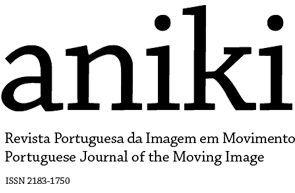'Nantes Triptych' de Bill Viola: Revelando as fontes da sua densa temporalidade
Resumo
Neste texto, pretendemos analisar a vídeo-instalação de Bill Viola, "Nantes Triptych" (1992), como exemplo da riqueza que jaz nos espaços entre artes. Defendemos a tese de que, nesta obra em particular, a utilização da tradicional estrutura pictórica do tríptico, juntamente com o poderoso material audiovisual, oferece ao espetador um acontecimento kairológico. Esta experiência temporal possibilita uma experiência existencial perante a vídeo-instalação. Para desenvolver esta hipótese, iremos recorrer a textos teóricos da arte clássica sobre trípticos bem como, entre outros, aos textos de Deleuze sobre a imagem-tempo e a estrutura do tríptico, ao conceito de kairos em Agamben, ao conceito de obra de arte kairológica cunhada por David Chan e à filosofia da temporalidade desenvolvida por Merleau-Ponty.Referências
Agamben, Giorgio. 1999. “Aby Warburg and the Nameless Science”, in Potentialities: Collected Essays in Philosophy, trans. and ed. by Daniel Heller-Roazen. Stanford: Stanford University Press, 89-103.
Agamben, Giorgio. 2005. The Time That Remains: A Commentary on the Letter to the Romans, transl. by Patricia Dailey. Stanford: Stanford University Press.
Agamben, Giorgio. 2011. “Nymphs”, in Releasing the Image: From Literature to New Media. ed. by Jacques Khalip and Robert Mitchell. Stanford: Stanford University Press, 60-80.
Barker, Timothy Scott. 2012. Time and the Digital: connecting technology, aesthetics, and a process philosophy of time. Hannover, Dartmouth College Press.
Bernardini, Anna (ed.). 2012. Bill Viola Reflections. Milan: Silvana Editoriale.
Chan, Paul. 2010. “A Time Apart”, in Greater New York, ed. by Klaus Biesenbach. New York, MoMA PS1: 84-85.
Deleuze, Gilles. 1989. Cinema 2 The Time-Image, trans. by Hugh Tomlinson and Robert Galeta. Minneapolis: University of Minnesota Press.
Deleuze, Gilles. 2003. Francis Bacon the logic of sensation, trans. by Daniel W. Smith. New York: Continuum, 2003.
Gayford, Martin. 2003. “The Ultimate Invisible World: Interview with Bill Viola”, Modern Painters, 16: 22-25.
Guzman, Alissa. 2009. “Conversation with Bill Viola”, Whitehot Magazine, December. http://www.whitehotmagazine.com/articles/in-conversation-with-bill-viola/1979.
Hansen, Mark. 2004. “The Time of Affect, or Bearing Witness to Life”. Critical Inquiry, 30: 3, 584-626.
Heartney, Eleanor. 2002. “Video Installation and the Poetics of Time," in Outer & Inner Space ed. by John B. Ravenal. Virginia: Museum of Fine Arts, 14-21.
Jacobs, Lynn. 2012. Opening Doors: The Early Netherlandish Triptych Reinterpreted. Pennsylvania: Penn State University Press.
Lankheit, Klaus. 1959. Das Triptychon als Pathosformel, Heildeberg: Carl Winter Universitätsverlag.
Leston, Robert. 2013. “Unhinged: Kairos and the Invention of the Untimely”, Atlantic Journal of Communication, 21: 1, 29-50.
Manchester, Elizabeth. 2000. “Nantes Triptych.” TATE, accessed June 17, 2014, http://www.tate.org.uk/art/artworks/viola-nantes-triptych-t06854.
Mennekes, Friedhelm. 1999. “Nantes Triptych”, in Bill Viola Europäische Einsichten | European Insights, ed. by Rolf Lauter. Munich: Prestel Verla: 223-234.
Merleau-Ponty, Maurice. 2005. Phenomenology of Perception. Trans. by Colin Smith. New York: Routledge Classics.
Neumaier, Otto. 2004. “Space, time, video, Viola”, in The Art of Bill Viola, ed. by Chris Townsend. London: Thames & Hudson, 46-71.
Rush, Michael. 2005. New Media in Art. London: Thames & Hudson, 2005.
Smith, John. E. 1969. “Time, Times, and the 'Right Time'; Chronos and Kairos”, The Monist, 53(1): 1-13.
Townsend, Chris (ed.). 2004. The Art of Bill Viola. London: Thames & Hudson.
Viola, Bill. 1995. Reasons for Knocking at an Empty House. Writings 1973-1994, ed. Robert Violette, introduction of Jean-Christophe Amman. London: Thames & Hudson.
Viola, Bill. 2003. “The John Tusa Interview with Bill Viola.” 45 minutes. BBC Radio 3, London.
Walsh, John (ed.) 2003. “Emotions in Extreme Time: Bill Viola’s Passions Project,” in Bill Viola: The Passions. Los Angeles: J. Paul Getty Museum in association with the National Gallery.





